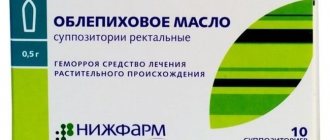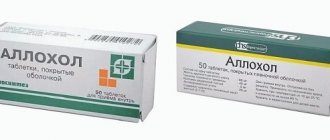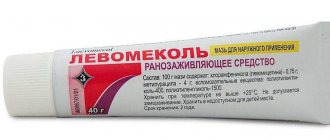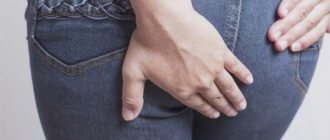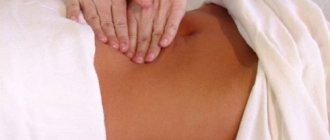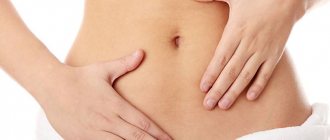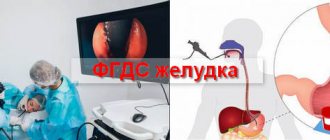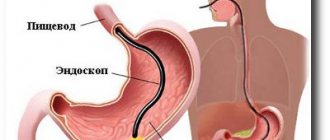Who is recommended for massage to improve digestion?
The digestive system does not always perform its function perfectly. A person is largely to blame for himself, consuming poor-quality food and not observing basic rules of cleanliness. As a result, indigestion or constipation occurs. Gastroenterologists prescribe medication and massage therapy to improve the condition.
Sessions are prescribed for colitis, gastritis, adhesions, stomach ulcers and other diseases. You can massage the stomach area at home, but it is more effective to trust an experienced massage therapist. Also, not everyone can receive massage from a doctor due to complications from organ diseases.
Main indications for massage:
- beginning constipation;
- heartburn;
- reflux;
- bloating;
- discomfort in the stomach;
- lack of appetite;
- sedentary lifestyle.
Few people know, but massage is an excellent prevention of many diseases. A targeted treatment, which anyone can master, is performed over the course of a month to eliminate discomfort. If you are not lazy, then such manipulations will improve the functioning of the whole body, help maintain good mood and improve well-being.
The purpose of massage is to normalize the secretion activity of the digestive organs, increase the body's resistance, resolve pathological problems and activate blood circulation.
Can massage cure gastrointestinal diseases?
Massage can normalize the functioning of the stomach and slow down the development of the disease, but it cannot completely cure it. It can stimulate the functioning of the stomach in case of many stomach ailments, so this procedure must be repeated. Massage can be done for the following diseases:
- Gastric and duodenal ulcers (in the initial stages).
- Massage for inflammation and gastritis, which has the ability to relieve inflammation and relieve pain in the abdominal area.
- Cure diseases caused by bacteria and viruses (rotavirus infection).
The procedure cannot completely cure the disease, especially if it is an aggravated form. Therefore, you should immediately consult with a gastroenterologist and if he prescribes it, then contact specialists for a professional massage. But if pain and nausea occur during the procedure, then it is better to refuse it or lubricate your hands with special ointments that will be prescribed by the attending physician. It is also prohibited to give massage to those who have oncology or acute diseases.
Contraindications for implementation
Despite the fact that this type of massage brings many benefits, there are situations in which it is contraindicated. Consult your doctor and perhaps he will prescribe gentle sessions that are right for you.
The main thing is not to overuse massage if you have:
- haemorrhoids;
- tuberculosis;
- damage to the skin of the abdomen;
- diseases of the pelvis and abdominal organs;
- oncology and neoplasms of unknown nature;
- nausea or vomiting;
- pregnancy at any stage and the postpartum period;
- heavy menstruation;
- fever;
- varicose veins;
- any contraindications from a doctor.
Contraindications
Only the attending doctor can prescribe a massage complex and the number of sessions, based on the patient’s clinical picture and the prescribed drug treatment. At the stage of exacerbation of the disease, massage therapy is strictly prohibited. The session is stopped if symptoms of heaviness, pain, discomfort and tingling in the left rib occur. Therapy is not carried out without X-ray and laboratory tests, as well as in the postoperative period. Massage is contraindicated for patients with tumors, diseases of the lymphatic system and blood problems.
Specifics
The best option is if the sessions are scheduled for the first half of the day. Please note that the massage is not done on an empty stomach. But it is also not recommended to overeat the day before. It is enough to prepare yourself a light breakfast that will not overload your stomach. 10 minutes before starting, drink a glass of mineral water. After completing the procedure, you should not pounce on food, even if you are ready to eat an elephant. A full bladder is also harmful when massaging the organs.
Wait about half an hour. The effect on the digestive system is enormous and it takes time for the work to return to normal.
Be sure to wash your hands with soap so that the cream does not absorb germs. For massage, use special pharmaceutical products, baby cream or oil for newborns. The warmer the massage therapist's palms are, the more pleasant the procedure will be.
What other properties does massage have?
It has many beneficial properties, and if done incorrectly, it can cause serious organ dysfunction. It is considered useful not only for the stomach, but also for:
- Hearts and cardiac muscles that work more steadily and efficiently.
- Lungs and respiratory system.
- Back and spine diseases can also be cured: flat feet, rickets, scoliosis, etc.
- For other muscles that, with massage, grow better, function and do not hurt.
- For the head and temples, which can slow down headaches and relieve them altogether.
Massage is one of the unique ways to externally stimulate the internal functioning of organs, so it is worth repeating this procedure or contacting specialists. It is also advisable to consult with a gastroenterologist and undergo a full examination, because if the disorders and diseases are acute, then massage will be critically contraindicated. It is capable of generally strengthening the functioning of the stomach and organs, so it is worth doing it correctly and carefully so as not to disturb anything or cause severe pain, which can turn into diseases or irritation of the walls of the ventricle.
How to master abdominal massage at home?
If you are wondering whether it is possible to influence the digestive system on your own, we will answer. Yes, it is possible and even necessary. Use two hands for maximum effect. So:
- Lying on your back, pull your legs towards your stomach. Breathe steadily, making sure that your breathing does not interrupt.
- Lower and raise your legs alternately, massaging your stomach at the same time.
- Continue pressing your abdominal muscles.
- To tone peristalsis, it is useful to perform frequent deep swallowing movements.
- Stand up, take a jump rope and jump over it 10-15 times.
- Rotate your waist clockwise and counterclockwise.
- Don’t be lazy to do bends and squats at least 10 times. Pump up your abs.
Self-massage is good because it can be performed at any time of the day, the required number of times. To do this, you do not need to go to the other end of the city. The duration of the massage is 15-20 minutes. Massage course – one month. Next, it is recommended to take a break for several months.
Types of massage
You have the right to choose how massage treatments will be performed.
- Spot. It is performed using the fingertips. Press on certain points in the gastrointestinal tract with one or two fingers for 30 seconds.
- Hardware. The technique is described in the instructions for the device. Do not overuse the intensity of the massager. What is suitable for the back can be dangerous for the delicate stomach and nearby organs.
- Segmental-reflex. It is done only by adults and only by specialists in a clinic office. Its action is aimed at relieving tension from the muscles running along the spinal column. By stretching across the fibers, the functioning of all internal organs improves.
- Vacuum. More suitable for those who want to improve the functioning of the digestive system in order to lose weight.
- Water. Performed using a stream of water. Useful for strengthening muscles and increasing blood circulation in the abdominal area.
Massage can also be done using honey.
Massage for gastritis
Home Medical encyclopedia Encyclopedia of massage Segmental massage
Gastritis is an inflammation of the stomach lining.
When prescribing a course of segmental massage, it is necessary to take into account the existence of two varieties of this disease: hyperacid and hypacid. In the hyperacid form of gastritis, the techniques and procedure for performing the massage are the same as in the hypacid form, but the massage therapist must perform all movements gently and smoothly, avoiding vigorous shaking and shaking of the abdomen.
The procedure for performing segmental massage in the treatment of gastritis:
1. The patient lies on his stomach, a cushion is placed under the ankle joints.
2. The massage begins from the back with alternate use:
- flat and enveloping stroking;
- "sawing";
- rubbing;
- intersection carried out on the lateral surfaces of the back and collar area;
- circular rubbing;
- longitudinal kneading in combination with rolling;
- continuous vibration;
- light pat.
3. Then the paravertebral zones (D9-5 and C5-4) are massaged using:
- "drilling";
- "sawing";
- effects on the spinous processes of the vertebrae.
Note: the above techniques should be carried out with increased pressure on the left half of the back, and when massaging the latissimus and trapezius dorsi muscles, on the lower corner of the left shoulder blade.
4. After this, the patient lies on his back with his legs bent, a pillow is placed under his back, and a bolster is placed under his knee joints.
5. The massage therapist begins to work on the sternocleidomastoid muscles of the cervical spine and on the anterior surface of the chest, paying special attention to segments D6-3 located on the left. Making movements from the sternum to the spinal column, he uses techniques such as rake-like stroking, rubbing and pressing.
6. The massage continues with influence on the epigastric region, and the lines of influence should be directed from the navel to the sternum and back. The costal arches located on the left side and the supra- and subclavian areas are especially carefully massaged using stroking and rubbing, carried out from the sternum to the spine.
7. The next stage - stomach massage begins with circular stroking of the peri-umbilical area and rubbing with increased pressure on the left hypochondrium. Then the massage continues in the following sequence:
- stroking;
- trituration;
- continuous vibration;
- shaking with spread and slightly bent fingers in an upward direction from the left;
- stroking the sigmoid colon area from left to right.
In addition, when massaging the abdomen, you can use shaking and shaking (for the hypacid form of gastritis).
Note: to perform vibration during abdominal massage, it is recommended to use special devices with a frequency of 100 Hz and an amplitude of up to 0.3 mm.
The course of treatment with segmental massage consists of 12-15 sessions held every other day. The duration of one session is 10-15 minutes.
| print version | This information is not a guide to self-treatment. A doctor's consultation is required. |
Execution technique
Before doing a massage, it is worth familiarizing yourself with which technique is suitable for different organs. As a rule, the solar plexus and abdominal cavity are kneaded. When a specialist gets down to business, it seems like they are penetrating under the skin. In this case, you will not experience any unpleasant sensations.
You can perform the massage in a lying, sitting or standing position, but the first option is preferable.
In case of intestinal upset, light movements are performed clockwise for several minutes. A warm heating pad is first placed on the lower back to relax the muscles.
For constipation, three-finger massage is effective. Diagonally from the navel to the left, the place where feces accumulate inside is actively massaged. After or even during the session, there may be a urge to defecate. The therapeutic massage ends with stroking and light vibration movements.
Arc-shaped compression and rubbing of the costal arches improves the functioning of the gallbladder and liver. Stroking clockwise is also effective.
When an ulcer begins to develop, circular stroking movements are made around the navel, which must gradually increase in diameter. Then reduce the massage area again. Do this for at least 5 minutes.
Start and end any type of massage with stroking.
Feelings after the procedure:
- bloating goes away;
- lightness appears in the stomach;
- you want to have a bowel movement immediately;
- no redness on the skin;
- After regular massage for several months, weight loss of several kilograms is observed.
If you see blood in your stool, tell your doctor immediately. Also make sure that there is no pain during the procedure.
A lasting effect is noticeable when performing massage simultaneously with physical therapy, following a strict diet, physiotherapeutic procedures, taking medications and drinking plenty of fluids.
Features of the course of the disease can also affect the duration and effectiveness of treatment.
According to statistics, digestive problems occur in 40% of the population. Stomach discomfort interferes with normal life. A high-quality massage will help you forget about the problem for a long time or reduce its manifestations.
How to do a massage correctly?
How and to what extent the functioning of the stomach is stabilized depends on the ease and correctness of the massage.
There are many massage techniques, but for the stomach it is recommended:
- It is easy to do and without pressing, so as not to provoke pain and nausea.
- Lubricate your hands with some cream or wash with warm water.
- Gently move your hand from the navel and throughout the abdomen in a clockwise direction.
- Do it after meals, or 1 hour before.
- Do not press or hit, so as not to cause pain, nausea and improper pickling of food (volvulus and other disorders).
You can perform the procedure at home, but if you have no experience and this is your first time, then it is better to contact a massage therapist and get a professional wellness massage. It promotes the normal production of gastric acidity, and this helps the digestion process work much faster and more efficiently. The acid level is also normalized. But if you do the massage incorrectly, you can cause inflammatory processes, intestinal volvulus and other disorders that can have serious and not comforting consequences.


